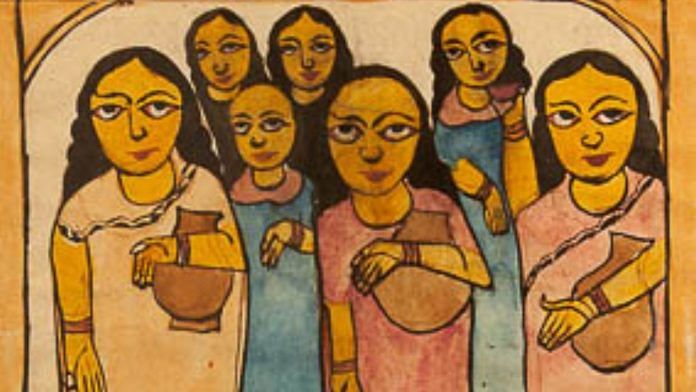A form of scroll painting on a cloth or canvas base — patta in Sanskrit — patua is part of a visual and oral storytelling tradition in the region of present-day West Bengal, India, and Bangladesh. The term refers to the painting form and the storytelling tradition, as well as the community of travelling artisans, the patuas, who have traditionally practised it. The word ‘patua’ carries three different connotations simultaneously. First, it refers to the Patuas, a caste from east India and Bangladesh whose hereditary occupation is handling the artwork. Second, it refers to the individual artisans engaged in painting or displaying scrolls. Third, it refers to the folk tradition of storytelling accompanied by scroll paintings in Bengal. In the patua tradition, all three meanings overlap often, but not always.
The history of patua is almost untraceable owing to its origins as a folk tradition based on oral storytelling with scant use for written records. Moreover, documents from the colonial period use the word ‘patua’ interchangeably for the caste and the practice, making it harder to discern which of the two is indicated in the records. Most scholars, however, agree that the tradition can be traced back to the tenth and eleventh centuries, even though the oldest surviving scroll comes from the eighteenth century.
Although the practice of carrying patas, or scroll-paintings, and performing patua across villages on auspicious occasions and festivals was widespread in eastern India, it was especially popular in the Midnapore, Murshidabad, Birbhum and Purulia districts of Bengal. Members of the Patua caste — which belonged to the Islamic faith — also known as Chitrakars, would perform stories in a narrative style, also known as paater gaan, and display crucial scenes from the story by unravelling the scroll in an action known as pat khelano.
Also read: Kailasanatha Temple’s rock-cut glory even attracted Aurangzeb–Gopurams to Ravana sculptures
The narratives in the patas included themes from several textual and oral sources — the Ramayana and Mahabharata; religious texts like the Magalakavyas; stories of Radha and Krishna, Behula and Lakhinder, the renunciation of Chaitanya and Krishna Leela, to name a few. Originally painting on dried leaves, patua artisans eventually moved to cloth canvases using colours from naturally extracted pigments prepared in broken coconut shells. The patas thus painted bore decorative motifs such as flora and fauna along with the story.

cm | Image courtesy of Philadelphia Museum of Art
Depending on their themes, there are several different kinds of patas. The Satyapir Pata, known to be from pre-Partition Bengal, is part of a syncretic belief system that fuses various local faiths. The Santhali Pata — which illustrates the rituals and belief systems of the Santhal tribe — is also made by jadu patuas, or magic painters, from Singhbhum and adjoining areas. However, some scholars and researchers have wrongly attributed it to artists from the Santhal community initially. The Manasa Pata is centred around the snake goddess, Manasa, who cures diseases and grants fertility. The Jama Patas depicts Yama, the Hindu god of death, and some variations depict his assistants torturing subjects in hell.
Additionally, the patua tradition also led to the emergence of other art traditions in Eastern India. For instance, Kalighat paintings were created by the patuas who migrated to Calcutta (now Kolkata) in the eighteenth and nineteenth centuries and lived around the Kalighat Temple. These paintings, which were meant to be souvenirs, depicted single, simplified scenes and subjects as varied as the goddess Kali and satirical scenes from colonial Calcutta. In Odisha, too, the religious practice of patachitra at the Jagannath Temple was a fusion of oral bardic traditions and the patua.
Gurusaday Dutt, an Indian civil servant who was the district magistrate of Birbhum in 1930, devoted himself to collecting scroll paintings and songs, becoming instrumental in the popularisation and exhibition of patas in the twentieth century. The first public exhibition was organised at the Indian Society of Oriental Art, Calcutta in 1932, followed by another exhibition in Shantiniketan (now Visva Bharati University) in 1934. Dutt also wrote and published extensively, arguing that the Patua community claimed ancestry from the ancient Chitrakar caste, which was well-known as a painter caste across India.
This gave the Patuas a significant impetus and saw the second coming of the tradition. From then on, patua artisans have been commissioned by individuals and organisations to depict subjects beyond religion. From the 1970s onwards, patua artisans began incorporating political issues such as family planning, literacy campaigns, anti-dowry messages and environmental appeals. In the 1980s, the demand for patua increased substantially, as its popular usage in urban spaces led to greater demand outside of art collecting circles. Since the 1990s, selling patua paintings has become the mainstay of many artists. Painting in the contemporary Kalighat style, Kalam Patua, a postmaster in rural West Bengal, is one of the leading figures from the Patua community engaged in adapting patas to contemporary times.
As a result of increased commercial and cultural interest outside of rural Bengal, the patas came to be divorced from the performance-based folk tradition that consisted of visual and oral storytelling and got consolidated as visual folk art. In 1986 and 1991, the handicrafts board of West Bengal financed training courses for patuas artists in Midnapore, and in 1992, a workshop was organised at the Ashutosh Museum, Calcutta University. Presently, the artists have adapted the form to offer depictions of contemporary life and have shifted their scale to medium and small-size canvases to cater to the market.
This article is taken from the MAP Academy‘s Encyclopedia of Art with permission.
The MAP Academy is a non-profit, open-access educational platform committed to building equitable resources for the study of art histories from South Asia. Through its freely available digital offerings—Encyclopedia of Art, Online Courses, and Stories—it encourages knowledge-building and engagement with the visual arts of the region.



